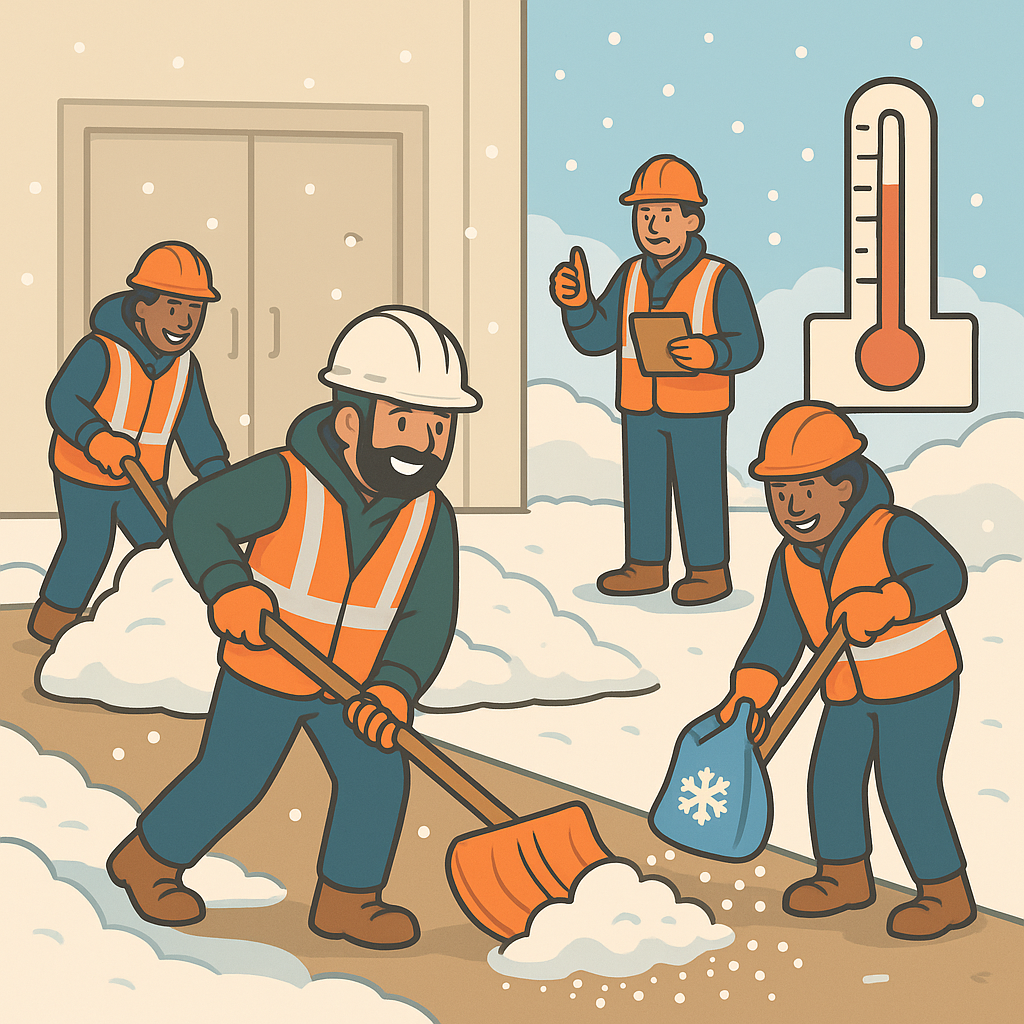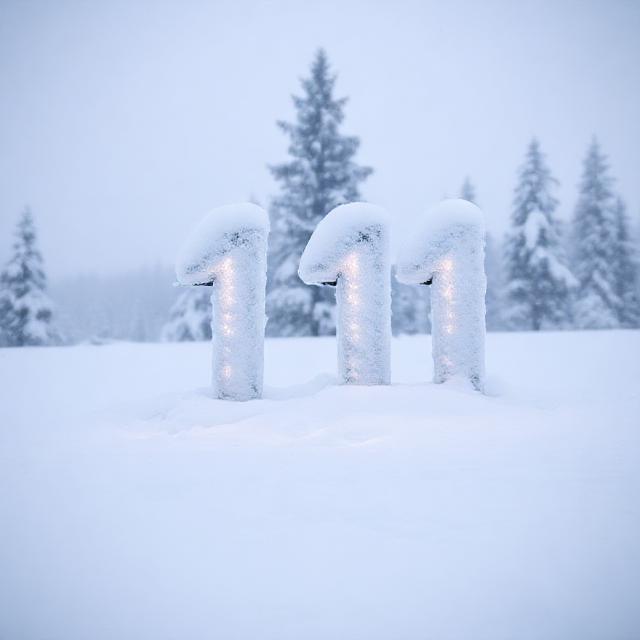Winter OHSE tips become critical as soon as temperatures drop, snow piles up, and daylight shrinks.
Cold weather turns everyday tasks into higher-risk activities: surfaces get icy, vehicles lose traction, workers layer up and lose dexterity, and fatigue sets in sooner.
A structured approach to winter OHSE tips helps you anticipate hazards, protect your people, and keep operations running safely all season.
- Winter OHSE tips for planning and leadership (1–15)
- Winter OHSE tips for slips, trips, and falls (16–35)
- Winter OHSE tips for driving, fleet, and commuting (36–55)
- Winter OHSE tips for outdoor work and cold stress (56–80)
- Winter OHSE tips for equipment, utilities, and facilities (81–95)
- Winter OHSE tips for people, training, and emergency response (96–111)
Quick winter risk snapshot
| Winter condition | Main risk | Example controls |
|---|---|---|
| Snow and ice | Slips, trips, falls | Prompt shovelling, de-icing, slip-resistant footwear |
| Extreme cold / wind | Frostbite, hypothermia | Break schedule, windbreaks, thermal PPE |
| Poor visibility | Pedestrian / vehicle collisions | High-vis clothing, lighting, traffic control |
| Shorter daylight | Fatigue, errors, security issues | Adjust shift times, better lighting, escorts |
| Storms and outages | Loss of heat, power, communications | Business continuity plans, backup power, checklists |
Use the following 111 winter OHSE tips as a toolbox. Pick what fits your operation, add your own, and share them through toolbox talks, safety boards, and your internal resources such as OHSE.ca or your learning portal.

Winter OHSE tips for planning and leadership (1–15)
- Make winter OHSE tips part of annual planning.
- Assign a “winter readiness” coordinator.
- Create a written winter safety procedure.
- Involve your joint health and safety committee.
- Review past winter incidents and trends.
- Align winter OHSE tips with local weather risks.
- Pre-qualify snow removal and salting contractors.
- Budget for sand, salt, and de-icer early.
- Stock extra PPE before the first storm.
- Add winter OHSE tips to supervisor training.
- Set clear criteria for cancelling outdoor work.
- Integrate winter conditions into risk assessments.
- Add winter hazards to job hazard analyses.
- Include winter OHSE tips in contractor orientations.
- Review emergency and business continuity plans.
Note: Build your winter checklist in September or October, not after the first icy near-miss.
Winter OHSE tips for slips, trips, and falls (16–35)
- Prioritize snow clearing at main entrances first.
- Mark high-risk slopes and ramps clearly.
- Use contrasting tape on icy stair edges.
- Provide slip-resistant winter footwear guidance.
- Reimburse or subsidize proper winter boots.
- Place extra floor mats inside all entrances.
- Install drip trays for wet umbrellas and boots.
- Add “wipe shoes” reminders at doorways.
- Keep handrails clear of ice and snow.
- Remove compacted snow, not just loose flakes.
- Apply de-icer before forecast freezing rain.
- Inspect walkways at least twice per shift.
- Log salting and shovelling in a simple form.
- Re-route traffic away from chronically icy areas.
- Provide walking aids or escorts for patients.
- Encourage short, shuffling steps on ice.
- Require carrying smaller loads in bad weather.
- Provide carts with large, winter-friendly wheels.
- Fix lighting in parking lots and paths quickly.
- Add slips-trip themes to winter toolbox talks.
Winter OHSE tips for driving, fleet, and commuting (36–55)

- Require winter tires where legally permitted.
- Inspect brakes, lights, and wipers pre-season.
- Stock ice scrapers and snow brushes in vehicles.
- Keep extra washer fluid rated for low temperatures.
- Create a winter vehicle inspection checklist.
- Train drivers on skid recovery and braking distances.
- Emphasize “slow down, don’t rush for schedule.”
- Add winter OHSE tips to driver safety meetings.
- Set minimum following distances in policies.
- Require full window and roof clearing before departure.
- Prohibit phone use while driving, even hands-free.
- Plan routes using plowed, well-lit roads first.
- Avoid reversing where visibility is poor or snowy.
- Provide reflective vests for roadside work.
- Equip vehicles with blankets and small kits.
- Encourage employees to report dangerous road sections.
- Coordinate with local weather and road reports.
- Allow flexible start times after heavy storms.
- Encourage carpooling from cleared, central locations.
- Promote safe commuting tips through HR newsletters.
Winter OHSE tips for outdoor work and cold stress (56–80)
- Train workers to recognize frostbite and hypothermia.
- Use a buddy system in very cold weather.
- Define temperature and wind-chill action levels.
- Shorten outdoor shifts as temperatures drop.
- Schedule heaviest work for warmest daylight hours.
- Provide heated shelters or warm-up trailers.
- Offer warm drinks—avoid caffeinated overload.
- Encourage layered clothing, moisture-wicking base.
- Specify windproof outer layers in PPE requirements.
- Provide insulated, waterproof gloves and boots.
- Use balaclavas or liners under hard hats.
- Rotate workers between warm and cold tasks.
- Watch for reduced dexterity when handling tools.
- Choose tools with larger, glove-friendly grips.
- Remind workers to keep clothing dry and change quickly.
- Discourage cotton socks and hoodies as base layers.
- Clarify when facial coverings are PPE vs. comfort.
- Encourage wellness checks for workers with conditions.
- Add winter OHSE tips to health surveillance programs.
- Consider medical restrictions for extreme cold work.
- Use windbreaks or temporary barriers at job sites.
- Control snow loads on scaffolds and platforms.
- Inspect guardrails regularly for ice and damage.
- Prevent icicles forming above walkways or doors.
- Tag and restrict access to unsafe outdoor structures.
Note: Cold affects decision-making. Combine winter OHSE tips with fatigue management and mental health supports.
Winter OHSE tips for equipment, utilities, and facilities (81–95)
- Protect outdoor hoses and lines from freezing.
- Label and test emergency shut-offs before storms.
- Inspect roofs for snow loading safely.
- Use lockout/tagout when clearing jammed snow equipment.
- Maintain heaters and boilers per manufacturer guidance.
- Keep exits, hydrants, and sprinklers free of snow.
- Mark buried equipment and curbs with tall stakes.
- Store salt and sand where it stays loose and dry.
- Prevent extension cords from running through slush.
- Use GFCI protection on outdoor electrical equipment.
- Check backup power and UPS systems monthly.
- Ensure carbon monoxide detectors are installed and tested.
- Vent combustion heaters properly in enclosed spaces.
- Control indoor humidity to reduce fogged windows.
- Update floor plans and muster points for winter conditions.
Winter OHSE tips for people, training, and emergency response (96–111)
- Launch a seasonal winter OHSE tips campaign.
- Mix posters, toolbox talks, and short videos.
- Train supervisors to spot cold-related behaviour changes.
- Refresh first aiders on cold stress treatment.
- Include language and visuals for diverse workforces.
- Use real incident case studies in training.
- Encourage workers to speak up about unsafe conditions.
- Add near-miss reporting specific to winter hazards.
- Reward teams for proactive winter safety ideas.
- Include mental health supports during dark months.
- Coordinate with IT for remote-work options in storms.
- Update contact lists before storm season starts.
- Test mass notification and call-out systems.
- Run at least one winter emergency drill.
- Review all winter OHSE tips each spring for improvements.
- Capture lessons learned on your safety portal and share.
Pulling it all together
When you weave these winter OHSE tips into your existing safety program—policies, risk assessments, training, inspections, and contractor management—you create a resilient system that can handle snowstorms, cold snaps, and icy surprises without scrambling.
Use your internal channels, from team meetings to your OHSE knowledge base and intranet, to keep winter OHSE tips visible and practical.
The goal is simple: every worker, visitor, and contractor goes home safe and warm, no matter how severe the winter.


No comments yet